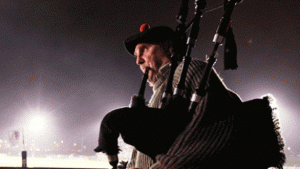 We’ve all seen them Scottish bagpipe and kilt wearing dudes. If you’re like me though then you’re probably wondering if there is more history to them than just being part of Scottish culture. I don’t even know if only Scots wear kilts now. I think sometimes they’re worn just for the cool factor. I don’t think I could pull that off though with my legs. Mine are more for running, not tree trunks or William Wallace like. But for those who can, more power to them. So let’s take a look at these Scottish Bagpipes and Kilts that the Highlanders used.
We’ve all seen them Scottish bagpipe and kilt wearing dudes. If you’re like me though then you’re probably wondering if there is more history to them than just being part of Scottish culture. I don’t even know if only Scots wear kilts now. I think sometimes they’re worn just for the cool factor. I don’t think I could pull that off though with my legs. Mine are more for running, not tree trunks or William Wallace like. But for those who can, more power to them. So let’s take a look at these Scottish Bagpipes and Kilts that the Highlanders used.
Scottish bagpipes are well-known throughout the world for one reason – they are quite odd. I do think they look manly though compared to other instruments. To a person like me that has never been to Scotland, bagpipes are much different than anything I have come across and they look tough (as in requiring muscle) to play. Most instruments I’m familiar with from different cultures are made entirely of metal or wood. And they don’t use a bag to keep a constant airflow through the instrument. I don’t think I can recall any instrument with an airbag.
Scottish Bagpipe Fun Facts
Contrary to popular opinion, historians say the Scottish bagpipe was actually not originally created in Scotland. They say bagpipes have been found to be dated all the way back to 1000 B.C., as evidence was found on a slab from this era in the Middle East. Bagpipes were also found to have been used by the ancient Romans, which is a little interesting if you think about it. Ancient Romans were well-known for having skirt-like armor (Pteruges) that they would wear into battle. Even the Emperor Nero is thought to have played the bagpipe. Now as we know it, bagpipes are most prominent in Scotland, a country that is famous for its skirt-like kilts. A coincidence? Perhaps, but maybe there is more to it. Julius Caesar did take his legions into Great Britain and got pretty far north before ending his invasion and creating the Adrian Wall.
How do they get air in those things…
Puffed out cheeks and sucking in huge amounts air. Looks torturous and difficult. Hence needing enormous amounts of muscle. They use a blowpipe or blowstick where they blow air into the bag. Some you have to cover with your tongue while inhaling to stop air from getting out but most have a non-return valve to do this. Another way is to use bellows to pump air into the bag. This was invented around the 16th or 17th century and is still in use. Must of had something to do with that torturous image of playing the bagpipe. The bag was usually made out of animal skins but lately synthetic materials like Gore-Tex have been used. It’s airtight and helps control the air of flow allowing the bagpipe player to focus on getting air into it.
How is it played…
There’s this piece called the chanter that is bored internally and sticks out so the player can play it with two hands. It’s usually open ended and that’s why you hear that constant sound. There’s usually only one chanter, but sometimes two. Each chanter has a reed (Chanter reed) installed at the top. A reed is a thin piece of material that creates a vibrating sound. Some chanters have been known to be close ended or longer so the player can plug it on his leg to stop the sound.
Origin of the Scottish Kilts
Kilts are traditionally worn by bagpipe players, but few people actually know how the kilt came about. This is another interesting story in itself and this fun fact is going to surprise you.
Our story doesn’t begin in Scotland itself, but actually starts off in the neighboring country England. Thomas Rawlinson invented the kilt in 1727 so that poor people in England that couldn’t afford pants could still have something to wear. They were made with only a thin cloth that would provide poor people with the decency of covering their personal areas, while not forcing them to spend very much of the little money they had. Over time, the British Parliament decided to ban the kilt because they believed that it would infringe upon the British lifestyle. This was during the time that Scotland was rebelling against the British government, so this gave them a great idea. Instead of obeying parliament, overnight, the kilt became the central item that would visually show the difference between the Scottish and the British. It was a sign of rebellion, and would eventually become a traditional garment for the Scottish people. Funny how that came about and yes they did eventually win their freedom.
They’re really not originally from Scotland?
So neither the Scottish bagpipe nor kilt is originally from Scotland, but because the Highlanders kept them going is one reason we know about them to this day. They both play a part in their unique culture. And now you’ll even see them as a part of our culture here in the US for funerals and memorials especially by the military and police. Other countries also like the UK, Ireland and other parts of the Commonwealth have adopted them into their culture.
Interesting post, I guess it should not surprise me that neither are Scottish in origin. I don’t think I’d look good in a kilt either as I am sure it would cause hysterical blindness to those around me. I’ve always admired people who can play bagpipes as it just looks like a good bit of skill is required…and like you said muscle.
Yea, I’m not sure what inspired me to write about this because I haven’t watched Braveheart recently or seen anyone walking around in a kilt. It was one of those things where I was curiouis and googled it. I am wondering now though if I should try one on since I never have. We might look better than we think. haha!
1st – I’m Scottish.
Yup, kilts are still worn proudly in Scotland. For myself, I would wear them to formal events (weddings, prom-type events) but also to rugby games, and I was definitely not alone. I still plan on getting married in Canada with a kilt on.
They’re fecking expensive though – you’re looking at anywhere from $500-$1000 depending on what you get. So it’s funny that they used to be thought of as a poor man’s fashion choice haha.
Yes they’re manly, and girls love them too 😉
I wrote a paper on bagpipes in high school. England actually banned bagpipes when Scotland was rebelling because they were considered a war instrument – like the fife. But the act actually defined a bagpipe by the number of canters, so the Scots simply added another one to get around the act!
It seems a lot of the Scottish quirks come from that time period. Like the games like throwing the telephone poles. Brittan banned their training for war so they said, “hey, we’re just throwing a bunch of rocks and tree trunks around!”
Some more good fun facts! I agree, it does seem a lot came out of the period of history. Thanks for sharing.
The reason you hear the constant tone is actually thanks to the pipes on top of the bagpipes (at least in the images you have posted. They can also run parallel to the chanter). They’re called drones.
Other than that, excellent piece!
Bjorn, thanks for commenting and the clarification.